Jeanneau Sun Fast 3200
This European award winner is what performance sailors have been dreaming about
Sailing, at its core, is an irrational enterprise. And that's why it so seductive, so addicting. Sure we describe boats in analytical terms in stern-faced reviews but let's face it, dreams and the stuff they're made of are as important to the sailboat industry as the development of new designs and technologies. With this in mind, enter the new Jeanneau Sun Fast 3200. This is an infusion-molded, vacuum-bagged dream machine. It is an Open 60 for the rest of us. I know it has an LOA of just 33 feet, 3 inches, and is surprisingly affordable, but the 3200 is so much fun to sail that it doesn't take much imagination to picture yourself surfing down monster Southern Ocean waves or racing a deep depression across the Bay of Biscay.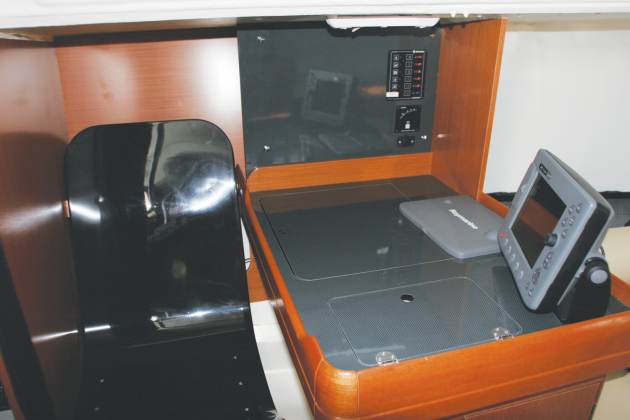
Designed by Daniel Andrieu, I'd be shocked if the 3200 does not develop into a formidable one-design class. The boat appeals on many levels. Andrieu has a long association with Jeanneau and designed some of its most successful offshore boats, including the Sun Magic 44, a frequent Admiral's Cup winner in the 1980s. In that same time period he also designed the Beneteau First 38, a great sailing boat that is coveted as a bluewater cruiser today. 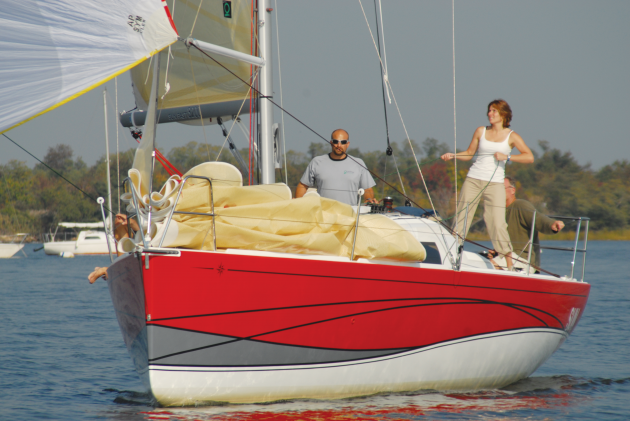
I mention these older designs because in a roundabout way they help define the 3200. Andrieu, who is firmly rooted in the present and no doubt cringes at the mention of those ancient models, has always designed fast boats, but he has done so without losing sight of the need for seaworthiness. Wait a minute you say, the 3200 is a flat out flyer designed for one-design racing on Chesapeake Bay right? Wrong. It is a flat out flyer, and there is no disputing that it's fun to sail on Chesapeake Bay... or Long Island Sound, or Biscayne Bay, or Lake St. Clair, but it is designed for ocean sailing.
The details
Introduced in Europe last year, the boat has already proven itself in numerous offshore events, including a one-two finish in the rugged Norwegian Two Star regatta. The hull shape actually does resemble an Open 60. The fine entry flares into a beamy midsection and holds that beam all the way aft. This shape provides form stability and aft sections that promote easy surfing. Twin high-aspect rudders provide great steering while running in big seas. And while numbers like a 26.4 sail area-to-displacement ratio and 150.3 displacement-to-length ratio suggest that the boat might be squirrely in a blow, Andrieu tempers things with a nearly 40 percent ballast-to-displacement ratio and a relatively deep-draft moderate L-shaped keel section. The 3200 is refreshingly stiff.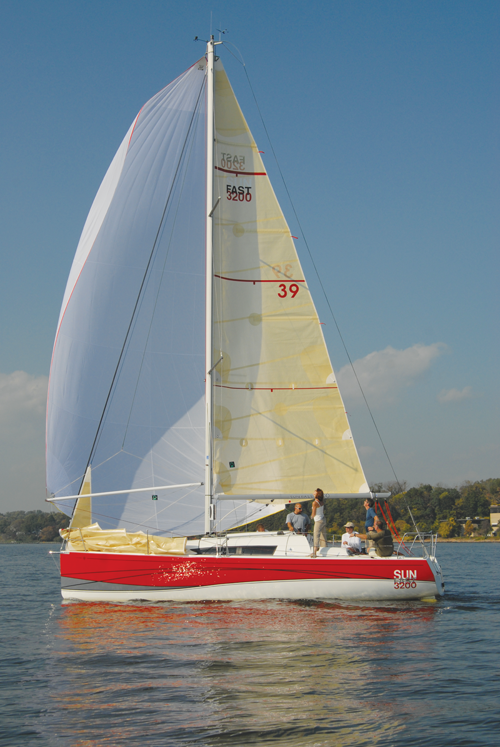
I was exited when the editors at SAILING told me that we would be sailing the new 3200 after the U.S. Sailboat Show in Annapolis. Unfortunately our test sail was on the Chesapeake Bay, not the Southern Ocean, but at least we had a decent breeze. The 3200 lived up to its billing the moment we hopped aboard. Sailing on a tight reach we accelerated easily and slipped past several lumbering cruisers as we sped out of congested Annapolis harbor. With just enough room to clear the Spider buoy we popped the chute, dropped the headsail and charged toward the Eastern Shore.
Andrieu's assignment was to design a fast, rewarding boat that would appeal to a wide spectrum of performance sailors and stand up to the rigors of ocean sailing. He hit the target dead on. The 3200 has already become a favorite for singlehanded and doublehanded sailors, and that is a testament to the boats performance and ease of handling. 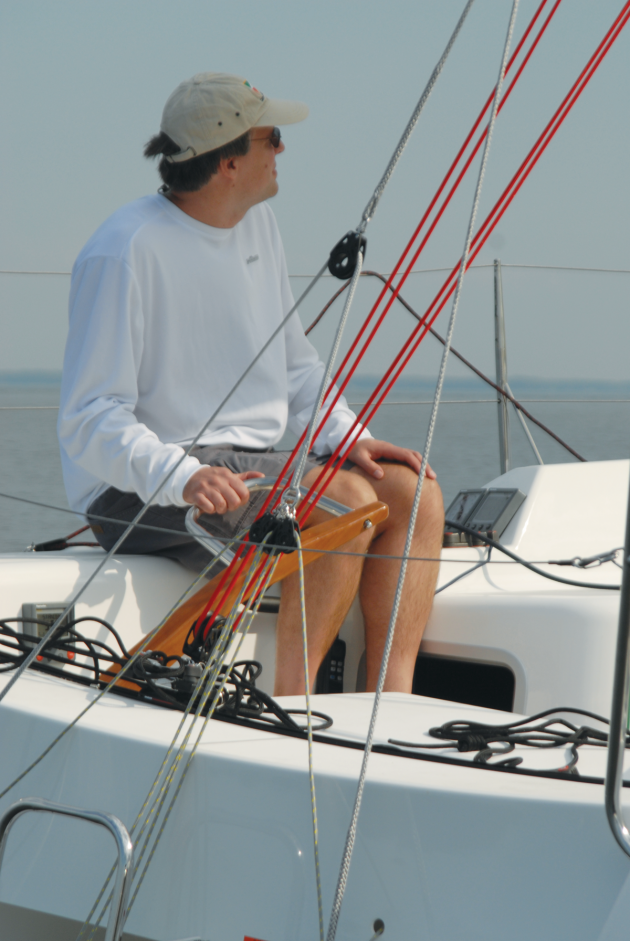
The hull is vacuum bagged with balsa coring. The deck is infusion molded; a clean, efficient laminating technique that Jeanneau is making standard on all its models. A foam-sandwich core makes the deck stiff and helps resist delamination. I love Jeanneau's construction philosophy: build a strong but light boat using the latest advances in materials all the while maintaining a profound respect for the ocean's moodiness. The main bulkhead is infusion molded, and the forward crash bulkhead is a composite material and watertight. A light but strong interior molded unit is held in place with adhesives. The keel is a combination of lead and iron and is epoxy coated.
On deck
The large cockpit is cleverly designed for both fully crewed and shorthanded sailing. The twin tillers, controlling two high-aspect rudders, provide the ideal helm control for either tack on any point of sail. I like the closed transom, it feels safer and also offers a stern platform with a fold-up ladder. The mainsheet traveler runs across a bench aft of the tillers and the multi-purchase sheet is trimmed forward of the helm. This arrangement takes a bit of getting used to, especially when quick tacking. A few times I found myself tangled in the sheet, but it does offer up incredibly efficient mainsail control and less clumsy sailors move a bit quicker than an old cruiser like me.
The sheet winches are mounted on deck just forward of the tillers with instrument pod repeaters behind. There are two watertight aft hatches for access to lockers and an ingenious centerline locker for storing the life raft. Two winches on the coachroof handle most sail controls. The adjustable backstay can be controlled from either helm. 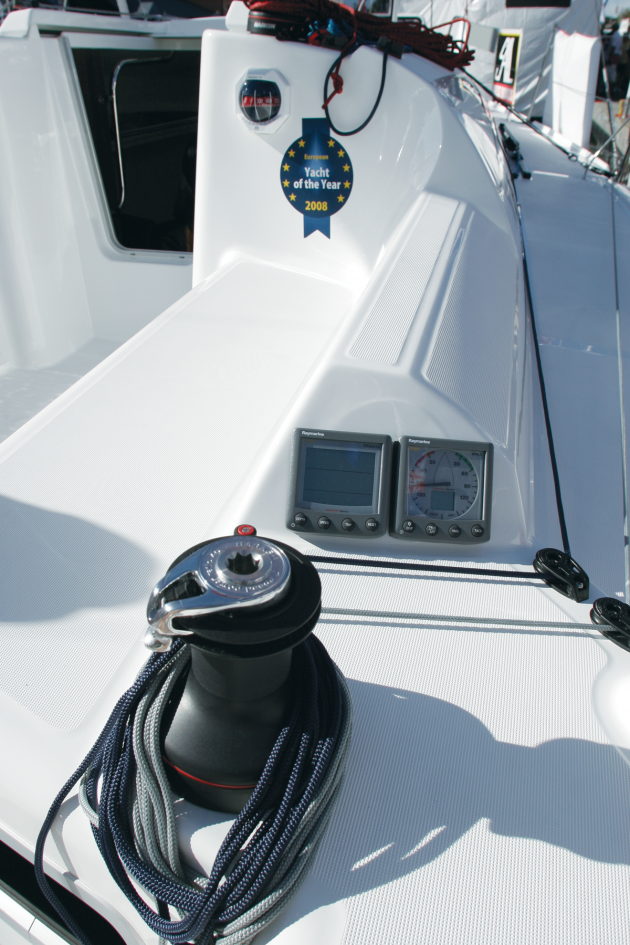
The 3200 has a keel-stepped Sparcraft mast. Jeanneau has elected to stick with aluminum spars for durability and to keep the costs down. The rig is, just barely, 19/20ths fractional and designed for the turbo-charging that only a masthead spinnaker can deliver. The air draft is 52 feet. Deck hardware is exclusively Harken, and top quality. I really like the line control genoa cars. We were able to quickly adjust the headsail leads under load.
The molded toerail is a subtle but essential safety feature when you're working the foredeck and hiking out. A short, stout stainless steel sprit, a feature I've noticed on boats all over the Med but rarely in the States, allows for the quick deployment of a Code 0-style furling headsail. I am convinced that large, light furling genoas/gennikers are a better bet in most situations than asymmetrical spinnakers, and when combined with a conventional chute offer the best range of downwind sailing options.
Down below
The 3200 interior is an intriguing blend of lightweight thinking and conventional design. The layout includes a sail locker all the way forward, followed by the athwartship head forward with a space-saving sliding door. The saloon includes a centerline table that drapes around the mast and long settee berths. It is a small touch but I like the standard lee clothes on each berth. 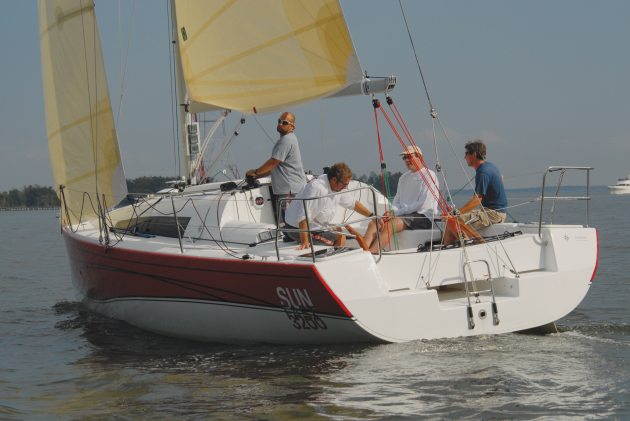
The galley is to starboard of the companionway and includes a lightweight laminate countertop with fiddles. There is a single stainless steel sink, a two-burner stove top and a large 16-gallon icebox. The nav station features a good-sized chart table with storage in the desk below. The laminate surface is designed for a laptop computer. The electrical panel is minimal, but includes a 12-volt outlet and engine voltmeter. The seat is well designed for support and to keep you in place while heeled.
The two identical aft cabins feature genuine double berths-this is where the wide beam aft becomes obvious-and clever removable fabric mattress covers. These cabins support Jeanneau's claim that the 3200 is a dual-purpose boat. And I confess the interior is surprisingly bright and comfortable. I like the fabric hanging lockers, they're light, spacious and can be removed easily. The doors are also fabric and that's a really good idea. Solid doors on a boat are always a nuisance, and there is only so much privacy to be had anyway. 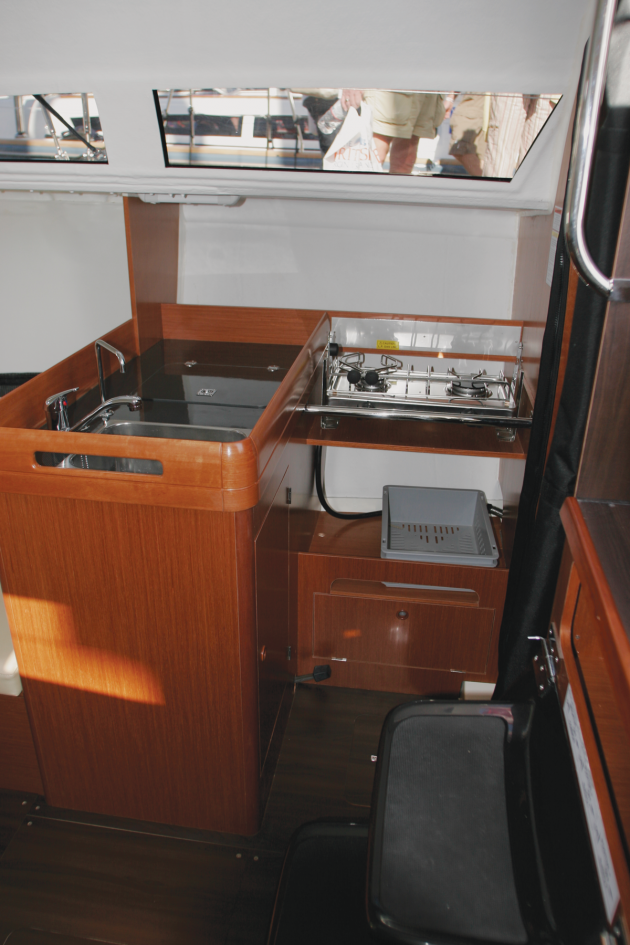
Naturally the 3200 is all about sailing, but Jeanneau has not skimped on the core systems. Water capacity is 21 gallons, fuel capacity is 20 gallons and I suspect most owners will opt for the optional Optima house battery. A 15-horsepower Yanmar diesel and saildrive transmission are standard. Engine access is from both cabins and from behind the companionway. The engine compartment is well insulated.
Under sail
Back on the bay, the wind was steady at 10 knots and we were making an impressive 7.5 to 8 knots on a beam reach, matching Andrieu's polar predictions spot on. Easing a bit deeper, we kept the boat moving well on a dead run. I will state that we passed several of the 3200's competitors as we followed the wind up the Severn River, but I won't name names. 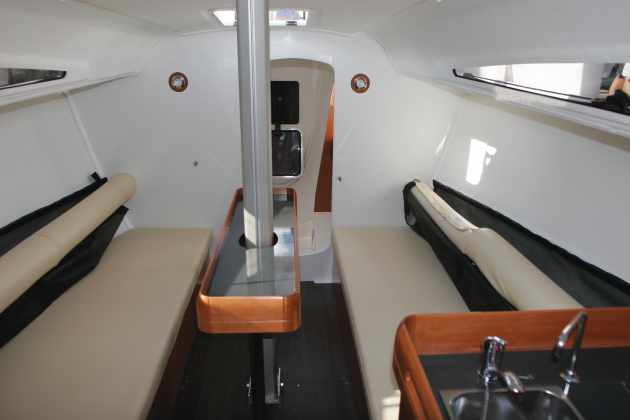
After several spinnaker jibes we dropped the chute and gave the 110-percent genoa a test. The helm was balanced as we came up hard on the wind. Pinching inside 40 degrees we kept moving at more than 6 knots. Giving up the helm I noticed for the first time that we had a real crowd aboard and yet the 3200 never felt crowded. The cockpit is very well thought out. 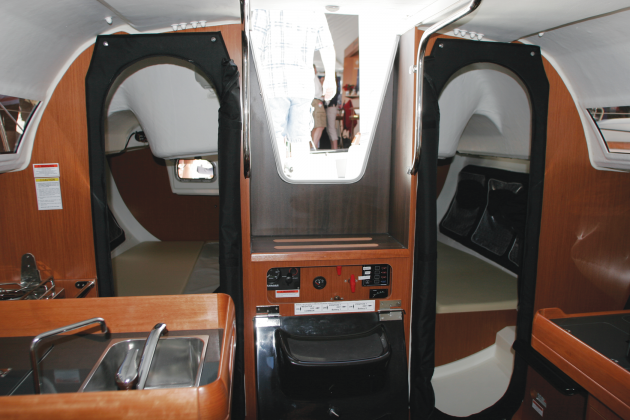
The new 3200, which incidentally was the European Yacht of the Year in 2008, is an intriguing blend of technology, performance and practicality. It is a boat for our times, and with a base price around $160,000 and the support of one of the world's premier builders, the 3200 just may be the answer to your dreams.

Comments